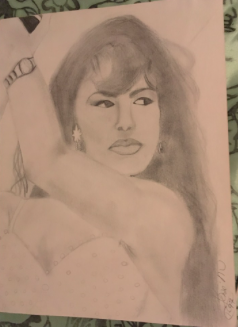Selena Quintanilla was my first pop-star crush, and I thought I’d share some thoughts since April is her birth month. I attended her last El Paso performance at the Coliseum in 1994 and had the fortune of shaking her hand. She reminded me of my sisters: Chicana, spoke in Spanglish and there were even some similarities in the way she dressed and did her hair. There was something different about Selena, her soulful voice and stage presence was more that of a pop star rather a Tejano singer. Because of her, I started listening to more Spanish music which ultimately would be a huge influence on me (in some other blog entry, I’ll discuss how Spanish rock and hip hop opened my eyes to corruption in Mexico and South America).

The day Selena was murdered my mom was so concerned that she picked me up from school to make sure I was ok. I was a junior at Alamogordo High and I really didn’t know any other Selena fans to speak of (apart from my bestie Imelda). Most of my friends listened to grunge, country or hip hop, all of which I love but there was just something about the essence of the Spanish language. I’d spend many hours locked away in my room sketching, listening to music and wondering about the outside world. For an introverted teen, music made me feel at peace and in a sense, safe.
I always knew Selena would be an icon, and I have been sketching and drawing her for over 20 years because I love what she represents to the Mexican-American community: creating your own American Dream through hard work. She continues to inspire.
Pop Art as Resistance
I understand there is complexity in using pop culture while advocating for social change, but it is an engaging tool, especially for younger audiences. A few years ago, I facilitated a workshop for 5th and 6th graders, where I discussed Selena as role model for her work ethic, charisma and talent. During the workshop, we discussed discipline and what it means to achieve goals. It was relatable, and students loved it. They discussed who they admired and were tasked to draw their favorite role model. A few drew their parents, but there were other nods to Leo Messi and Jenni Rivera. This is a very simple example of how art, culture and media can help trigger a student’s imagination and engage critical thinking.
The importance of representation, pop culture and media can be used to teach young people about leadership, identity, resiliency and instilling a stream of social consciousness. “Popular culture can help students deconstruct dominant narratives and contend with oppressive practices” (Morrell 2002). For more information on popular culture as a critical pedagogy, click here.
Why does it matter?
The personal is political, although, there are subliminal ways to be outspoken. I want my art and philosophy to contribute to a healing energy. For it is in representation that we start a new revolution. I hope my artistry can contribute to a larger-scale cultural resistance that includes representation, pop culture and creativity. I have some work to do! 
Music is golden transparencies of honey reflected in the sunlight. A Harvard study found that music heals. Now I’m not claiming that Selena is healing anyone, but I know the solace I found as a teenager listening and dancing to her cumbias. More importantly, I see a cultural resistance taking form, broadly speaking, and I couldn’t be happier that her image is always associated with it.

I love how your art and social conscience always rings true and inspires so many! I am so thankful and proud of you my amigosh ❤️
LikeLike